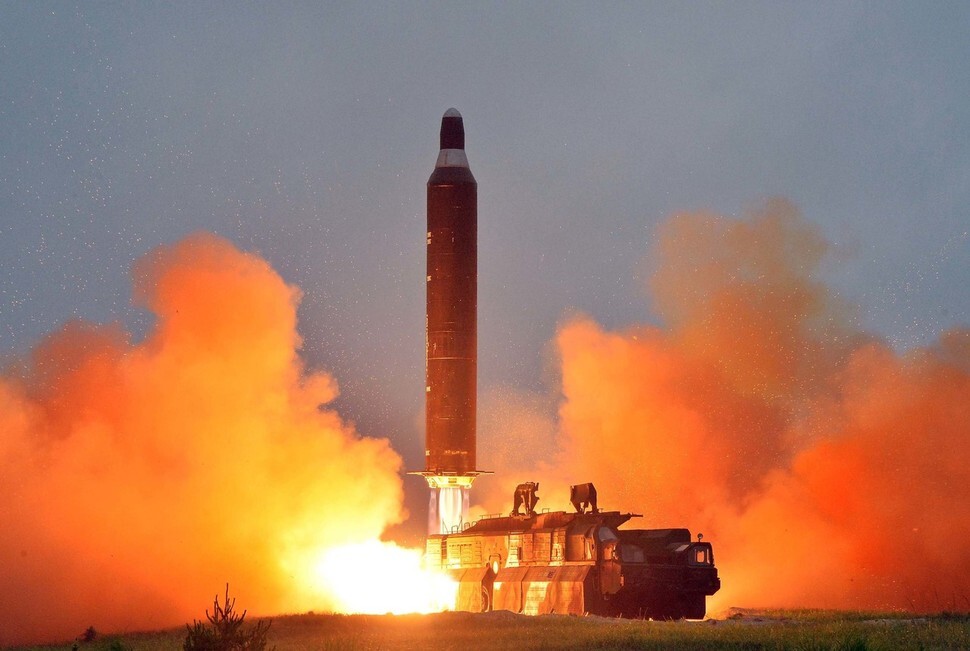hankyoreh
Links to other country sites 다른 나라 사이트 링크
[Analysis] Can THAAD intercept North Korea’s Pukguksong-2 ballistic missile?

The National Intelligence Service (NIS) reported to the National Assembly on Feb. 14 that the Pukguksong-2 ballistic missile launched by North Korea on Feb. 12 was fired at a high angle of 89 degrees and would have a firing range of 2,000 km if fired at a normal angle.
The NIS also said the missile traveled at a speed of Mach 8.5, or 8.5 times the speed of sound, which conflicts with military intelligence authorities’ assessment that its speed was “Mach 9.5 or higher.” The discrepancy raised questions over whether intelligence agencies are exchanging even basic information.
In response to the controversy, the NIS belatedly revised its number, saying the “report to the Intelligence Committee was based on initial analysis” and that the “comprehensive analysis showed a flight speed of Mach 10.”
Pukguksong-2 range over 2,000 km“While a precise analysis has not yet been done, [the Pukguksong-2] travels over 2,000 km if fired straight rather than at a high angle,” Liberty Korea Party lawmaker Lee Cheol-woo reported the NIS as telling the National Intelligence Committee on Feb. 14.
But in its report to the National Assembly National Defense Committee the same time, the Ministry of National Defense described the Pukguksong-2 as a “new model of solid-propellant intermediate-range ballistic missile.”
The term intermediate-range ballistic missile (IRBM) refers to missiles with a range between 3,000 and 5,500 km, suggesting different conclusions from the two agencies on the missile’s range.
North Korea has not stated a range for its missile. A Feb. 13 report by the Korean Central News Agency described it only as a “intermediate-range strategic ballistic missile.” South Korean military authorities typically translate IRBM into Korean as “junggeori,” or “medium range,” but some experts also use the alternate term “jungjanggeori,” or “medium-long range.” Based on this usage, North Korea’s Pukguksong-2, as a “intermediate-range” strategic ballistic missile, is seen having a range of 3,000 to 5,500 km, regardless of whether the facts confirm this.
A development that attracted some attention with the latest North Korean launch was the first observed use of a tank-tread launch vehicle. The NIS reportedly dismissed this, claiming the “movement speed slowed due to the change from wheels to treads.”
Lee Cheol-woo quoted the NIS as speculating that North Korea used the tank tread vehicle - when a faster wheeled vehicle would have been better - because it “could not import a special truck from China.” The claim is that North Korea procured the tracked vehicle on its own after China blocked the exporting of wheeled vehicles that could potentially be diverted for military purposes - a case of playing up the effectiveness of United Nations sanctions.

When asked by National Defense Committee lawmakers on Feb. 14 whether the North’s introduction of a solid fuel missile had rendered South Korea’s kill chain useless, Minister of National Defense Han Min-koo claimed it had not. The kill chain is an operational concept involving preemptively striking once signs of an imminent North Korean missile attack are detected. Unlike liquid-fuel missiles, solid-fuel missiles like the Pukguksong-2 do not require fueling prior to launch - which means that much less time to detect signs in advance.
“It‘s difficult to know about fueling because it’s done in concealed settings,” Han said in response. “The fueling issue has not been a matter really considered in the kill chain.” The claim is that the use of solid-fuel missile should not make a response any more difficult.
The Terminal High Altitude Area Defense (THAAD) system currently being pursued by Seoul and the US military also re-emerged as an issue. In a meeting with reporters that day, Righteous Party lawmaker Yoo Seong-min argued for the addition of a new THAAD battery.
“The Pukguksong-2 has a speed of Mach 10, which is almost impossible to defend against with Patriots,” he said.
But a missile with a 2,000-km range fired from North Korea would travel far beyond the Korean Peninsula. The question also remains as to why North Korea would insist on using a missile like the Pukguksong-2 against the South when it has Scuds with ranges of 300 to 1,000 km.
Another debate concerns whether THAAD would be capable of intercepting the Pukguksong-2. Lee, who heads the Intelligence Committee, said THAAD was capable of “intercepting [missiles traveling at] up to Mach 14.”
The Joint Chiefs of Staff said that while the maximum speed during the Pukguksong-2‘s ascent was Mach 9.5 or more, a determination of its descent speed “requires additional analysis.” The descent speed is the key issue, since it is during descent that THAAD intercepts missiles. The question of whether a THAAD interception is possible remains impossible to predict until the Pukguksong-2’s descent speed is determined.
There is at least one standard for gauging it. Official US military materials state THAAD as being intended for interception of “medium-range ballistic missiles (MRBMs)” with ranges below 3,000 km. No interception tests have been conducted with missiles with longer ranges. If the Pukguksong-2 is an IRBM as the Ministry of National Defense and North Korea claimed, it would be beyond THAAD’s interception capabilities. If its range is over 2,000 km as the NIS claimed, it is believed to be within the capabilities of THAAD defense.
By Park Byong-su, senior staff writer
Please direct questions or comments to [english@hani.co.kr]

Editorial・opinion
![[Column] Has Korea, too, crossed the Rubicon on China? [Column] Has Korea, too, crossed the Rubicon on China?](https://flexible.img.hani.co.kr/flexible/normal/500/300/imgdb/original/2024/0419/9317135153409185.jpg) [Column] Has Korea, too, crossed the Rubicon on China?
[Column] Has Korea, too, crossed the Rubicon on China?![[Correspondent’s column] In Japan’s alliance with US, echoes of its past alliances with UK [Correspondent’s column] In Japan’s alliance with US, echoes of its past alliances with UK](https://flexible.img.hani.co.kr/flexible/normal/500/300/imgdb/original/2024/0419/2317135166563519.jpg) [Correspondent’s column] In Japan’s alliance with US, echoes of its past alliances with UK
[Correspondent’s column] In Japan’s alliance with US, echoes of its past alliances with UK- [Editorial] Does Yoon think the Korean public is wrong?
- [Editorial] As it bolsters its alliance with US, Japan must be accountable for past
- [Guest essay] Amending the Constitution is Yoon’s key to leaving office in public’s good graces
- [Editorial] 10 years on, lessons of Sewol tragedy must never be forgotten
- [Column] A death blow to Korea’s prosecutor politics
- [Correspondent’s column] The US and the end of Japanese pacifism
- [Guest essay] How Korea turned its trainee doctors into monsters
- [Guest essay] As someone who helped forge Seoul-Moscow ties, their status today troubles me
Most viewed articles
- 1[Column] The clock is ticking for Korea’s first lady
- 2Hong Se-hwa, voice for tolerance whose memoir of exile touched a chord, dies at 76
- 3After 2 months of delayed, denied medical care, Koreans worry worst may be yet to come
- 4[Column] Has Korea, too, crossed the Rubicon on China?
- 5Samsung barricades office as unionized workers strike for better conditions
- 6US overtakes China as Korea’s top export market, prompting trade sanction jitters
- 7All eyes on Xiaomi after it pulls off EV that Apple couldn’t
- 8[Guest essay] How Korea turned its trainee doctors into monsters
- 9[Editorial] As it bolsters its alliance with US, Japan must be accountable for past
- 10[Correspondent’s column] In Japan’s alliance with US, echoes of its past alliances with UK